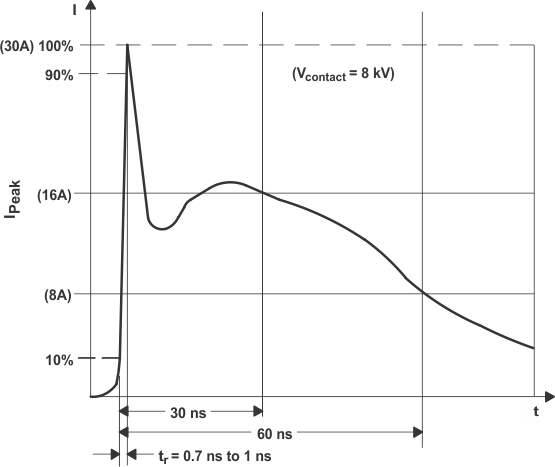SLLS789E April 2007 – December 2022 TRS3243E
PRODUCTION DATA
- 1 Features
- 2 Applications
- 3 Description
- 4 Revision History
- 5 Pin Configuration and Functions
- 6 Specifications
- 7 Parameter Measurement Information
- 8 Detailed Description
- 9 Application and Implementation
- 10Device and Documentation Support
- 11Mechanical, Packaging, and Orderable Information
Package Options
Mechanical Data (Package|Pins)
Thermal pad, mechanical data (Package|Pins)
- RHB|32
Orderable Information
9.1.1.4 IEC61000-4-2 (Formerly Known as IEC1000-4-2)
Unlike the HBM, MM, and CDM ESD tests that apply to component level integrated circuits, the IEC61000-4-2 is a system-level ESD testing and performance standard that pertains to the end equipment. The TRS3243E is designed to enable the manufacturer in meeting the highest level (Level 4) of IEC61000-4-2 ESD protection with no further need of external ESD protection circuitry. The more stringent IEC test standard has a higher peak current than the HBM, due to the lower series resistance in the IEC model.
Figure 9-4 shows the IEC61000-4-2 model, and Figure 9-5 shows the current waveform for the corresponding ±8-kV contact-discharge (Level 4) test. This waveform is applied to a probe that has been connected to the DUT. On the other hand, the corresponding ±15-kV (Level 4) air-gap discharge test involves approaching the DUT with an already energized probe.
 Figure 9-4 Simplified IEC61000-4-2 ESD Test Circuit
Figure 9-4 Simplified IEC61000-4-2 ESD Test Circuit Figure 9-5 Typical
Current Waveform Of IEC61000-4-2 ESD Generator
Figure 9-5 Typical
Current Waveform Of IEC61000-4-2 ESD Generator